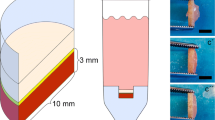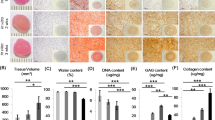Abstract
Cartilage repair strategies have utilized a wide range of cell types at a similarly wide range of seeding densities, both of which may affect ECM assembly. In this study, we investigated the effects of cell type and seeding density on proteoglycan assembly and the associated mechanical properties of tissue engineered constructs. Bovine and equine articular chondrocytes (AC) and first (P1) and second passage (P2) equine mesenchymal stem cells (MSCs) were encapsulated into alginate disk gels at densities of 1-, 10-, 25-, and 50 × 106 cells/mL for chondrocytes, and 25 × 106 cells/mL for P1-MSCs and 1-, 10-, and 25 × 106 cells/mL for P2-MSCs. Glycosaminoglycan content of the gels and surrounding media, as well as the resulting aggregate modulus of the disks was quantified at times up to 6 weeks. GAG accumulation was found to depend on cell type and density, and was observed to change with time. P1-MSCs produced the most total GAG (gel + media). Retention of GAG in gels was highest for bovine AC gels (which were used as a gold standard comparison), with equine MSCs retaining the least GAG. Though P1-MSCs were able to produce the largest amount of GAG, their ability to retain the produced GAG was very limited. This deficiency in retention by MSCs may be related to the lack of accumulation of link protein in MSC seeded gels. This is consistent with the lower amounts of GAG found in stem cell seeded gels by several studies, but also begins to elucidate metabolic patterns of MSCs. Future studies in cartilage engineering utilizing MSCs should explore ways of enhancing GAG retention.








Similar content being viewed by others
References
Almarza, A. J., and K. A. Athanasiou. Effects of initial cell seeding density for the tissue engineering of the temporomandibular joint disc. Ann. Biomed. Eng. 33(7):943–950, 2005.
Buschmann, M. D., Y. A. Gluzband, A. J. Grodzinsky, and E. B. Hunziker. Mechanical compression modulates matrix biosynthesis in chondrocyte/agarose culture. J. Cell Sci. 108(Pt 4):1497–1508, 1995.
Caplan, A. I. Mesenchymal stem cells. J. Orthop. Res. 9(5):641–650, 1991.
Chang, S. C., J. A. Rowley, G. Tobias, N. G. Genes, A. K. Roy, D. J. Mooney, C. A. Vacanti, and L. J. Bonassar. Injection molding of chondrocyte/alginate constructs in the shape of facial implants. J. Biomed. Mater. Res. 55(4):503–511, 2001.
Darling, E. M., and K. A. Athanasiou. Rapid phenotypic changes in passaged articular chondrocyte subpopulations. J. Orthop. Res. 23(2):425–432, 2005.
Enobakhare, B. O., D. L. Bader, and D. A. Lee. Quantification of sulfated glycosaminoglycans in chondrocyte/alginate cultures, by use of 1,9-dimethylmethylene blue. Anal. Biochem. 243(1):189–191, 1996.
Fuchs, J. R., S. Terada, D. Hannouche, E. R. Ochoa, J. P. Vacanti, and D. O. Fauza. Engineered fetal cartilage: structural and functional analysis in vitro. J. Pediatr. Surg. 37(12):1720–1725, 2002.
Genes, N. G., J. A. Rowley, D. J. Mooney, and L. J. Bonassar. Effect of substrate mechanics on chondrocyte adhesion to modified alginate surfaces. Arch. Biochem. Biophys. 422(2):161–167, 2004.
Giannoni, P., A. Crovace, M. Malpeli, E. Maggi, R. Arbico, R. Cancedda, and B. Dozin. Species variability in the differentiation potential of in vitro-expanded articular chondrocytes restricts predictive studies on cartilage repair using animal models. Tissue Eng. 11(1–2):237–248, 2005.
Gleghorn, J. P., A. R. Jones, C. R. Flannery, and L. J. Bonassar. Boundary mode frictional properties of engineered cartilaginous tissues. Eur. Cell Mater. 14:20–28, 2007; discussion 28-9.
Gleghorn, J. P., C. S. Lee, M. Cabodi, A. D. Stroock, and L. J. Bonassar. Adhesive properties of laminated alginate gels for tissue engineering of layered structures. J. Biomed. Mater. Res. A 85(3):611–618, 2008.
Hunter, C. J., J. K. Mouw, and M. E. Levenston. Dynamic compression of chondrocyte-seeded fibrin gels: effects on matrix accumulation and mechanical stiffness. Osteoarthritis Cartilage 12(2):117–130, 2004.
Kim, Y. J., R. L. Sah, J. Y. Doong, and A. J. Grodzinsky. Fluorometric assay of DNA in cartilage explants using Hoechst 33258. Anal. Biochem. 174(1):168–176, 1988.
Kobayashi, S., A. Meir, and J. Urban. Effect of cell density on the rate of glycosaminoglycan accumulation by disc and cartilage cells in vitro. J. Orthop. Res. 26(4):493–503, 2008.
Langer, R., and J. P. Vacanti. Tissue engineering. Science 260(5110):920–926, 1993.
Mackay, A. M., S. C. Beck, J. M. Murphy, F. P. Barry, C. O. Chichester, and M. F. Pittenger. Chondrogenic differentiation of cultured human mesenchymal stem cells from marrow. Tissue Eng. 4(4):415–428, 1998.
Mahmoudifar, N., and P. M. Doran. Effect of seeding and bioreactor culture conditions on the development of human tissue-engineered cartilage. Tissue Eng. 12(6):1675–1685, 2006.
Mandl, E. W., S. W. van der Veen, J. A. Verhaar, and G. J. van Osch. Multiplication of human chondrocytes with low seeding densities accelerates cell yield without losing redifferentiation capacity. Tissue Eng. 10(1–2):109–118, 2004.
Mauck, R. L., B. A. Byers, X. Yuan, and R. S. Tuan. Regulation of cartilaginous ECM gene transcription by chondrocytes and MSCs in 3D culture in response to dynamic loading. Biomech. Model. Mechanobiol. 6(1–2):113–125, 2007.
Mauck, R. L., S. L. Seyhan, G. A. Ateshian, and C. T. Hung. Influence of seeding density and dynamic deformational loading on the developing structure/function relationships of chondrocyte-seeded agarose hydrogels. Ann. Biomed. Eng. 30(8):1046–1056, 2002.
Mauck, R. L., M. A. Soltz, C. C. Wang, D. D. Wong, P. H. Chao, W. B. Valhmu, C. T. Hung, and G. A. Ateshian. Functional tissue engineering of articular cartilage through dynamic loading of chondrocyte-seeded agarose gels. J. Biomech. Eng. 122(3):252–260, 2000.
Mauck, R. L., X. Yuan, and R. S. Tuan. Chondrogenic differentiation and functional maturation of bovine mesenchymal stem cells in long-term agarose culture. Osteoarthritis Cartilage 14(2):179–189, 2006.
Mayne, R., M. S. Vail, P. M. Mayne, and E. J. Miller. Changes in type of collagen synthesized as clones of chick chondrocytes grow and eventually lose division capacity. Proc. Natl Acad. Sci. USA 73(5):1674–1678, 1976.
Mow, V. C., S. C. Kuei, W. M. Lai, and C. G. Armstrong. Biphasic creep and stress relaxation of articular cartilage in compression: theory and experiments. J. Biomech. Eng. 102(1):73–84, 1980.
Nicodemus, G. D., S. M. Giunta, and S. J. Bryant. Rational design of 3D hydrogels to capture and retain ECM molecules within mechanically stimulated PRG gels. In: 2009 Transactions of the Orthopaedic Research Society, Las Vegas, NV, 2009.
Panossian, A., S. Ashiku, C. H. Kirchhoff, M. A. Randolph, and M. J. Yaremchuk. Effects of cell concentration and growth period on articular and ear chondrocyte transplants for tissue engineering. Plast. Reconstr. Surg. 108(2):392–402, 2001.
Pittenger, M. F., A. M. Mackay, S. C. Beck, R. K. Jaiswal, R. Douglas, J. D. Mosca, M. A. Moorman, D. W. Simonetti, S. Craig, and D. R. Marshak. Multilineage potential of adult human mesenchymal stem cells. Science 284(5411):143–147, 1999.
Platt, D., T. Wells, and M. T. Bayliss. Proteoglycan metabolism of equine articular chondrocytes cultured in alginate beads. Res. Vet. Sci. 62(1):39–47, 1997.
Quinn, T. M., and A. J. Grodzinsky. Longitudinal modulus and hydraulic permeability of poly(methacrylic acid) gels—effects of charge-density and solvent content. Macromolecules 26(16):4332–4338, 1993.
Saini, S., and T. M. Wick. Concentric cylinder bioreactor for production of tissue engineered cartilage: effect of seeding density and hydrodynamic loading on construct development. Biotechnol. Prog. 19(2):510–521, 2003.
Sharma, B., C. G. Williams, T. K. Kim, D. Sun, A. Malik, M. Khan, K. Leong, and J. H. Elisseeff. Designing zonal organization into tissue-engineered cartilage. Tissue Eng. 13(2):405–414, 2007.
Sittinger, M., C. Perka, O. Schultz, T. Haupl, and G. R. Burmester. Joint cartilage regeneration by tissue engineering. Z. Rheumatol. 58(3):130–135, 1999.
Tran-Khanh, N., C. D. Hoemann, M. D. McKee, J. E. Henderson, and M. D. Buschmann. Aged bovine chondrocytes display a diminished capacity to produce a collagen-rich, mechanically functional cartilage extracellular matrix. J. Orthop. Res. 23(6):1354–1362, 2005.
Tuan, R. S. Cellular signaling in developmental chondrogenesis: N-cadherin, Wnts, and BMP-2. J. Bone Joint Surg. Am. 85-A(Suppl 2):137–141, 2003.
Veilleux, N. H., I. V. Yannas, and M. Spector. Effect of passage number and collagen type on the proliferative, biosynthetic, and contractile activity of adult canine articular chondrocytes in type I and II collagen-glycosaminoglycan matrices in vitro. Tissue Eng. 10(1–2):119–127, 2004.
von der Mark, K., V. Gauss, H. von der Mark, and P. Muller. Relationship between cell shape and type of collagen synthesised as chondrocytes lose their cartilage phenotype in culture. Nature 267(5611):531–532, 1977.
Wong, M., M. Siegrist, X. Wang, and E. Hunziker. Development of mechanically stable alginate/chondrocyte constructs: effects of guluronic acid content and matrix synthesis. J. Orthop. Res. 19(3):493–499, 2001.
Worster, A. A., A. J. Nixon, B. D. Brower-Toland, and J. Williams. Effect of transforming growth factor beta1 on chondrogenic differentiation of cultured equine mesenchymal stem cells. Am. J. Vet. Res. 61(9):1003–1010, 2000.
Xu, J. W., V. Zaporojan, G. M. Peretti, R. E. Roses, K. B. Morse, A. K. Roy, J. M. Mesa, M. A. Randolph, L. J. Bonassar, and M. J. Yaremchuk. Injectable tissue-engineered cartilage with different chondrocyte sources. Plast. Reconstr. Surg. 113(5):1361–1371, 2004.
Acknowledgments
This work was funded by the Alfred P. Sloan foundation and Cornell University. The authors thank Drs. Alan Nixon and Lisa Fortier, as well as members of the Comparative Orthopaedics Laboratory at Cornell University’s College of Veterinary Medicine for their assistance in the acquisition of the equine chondrocytes and mesenchymal stem cells. Mary Lou Norman is acknowledged for her help with the processing of the histology samples.
Author information
Authors and Affiliations
Corresponding author
Rights and permissions
About this article
Cite this article
Babalola, O.M., Bonassar, L.J. Effects of Seeding Density on Proteoglycan Assembly of Passaged Mesenchymal Stem Cells. Cel. Mol. Bioeng. 3, 197–206 (2010). https://doi.org/10.1007/s12195-010-0107-1
Received:
Accepted:
Published:
Issue Date:
DOI: https://doi.org/10.1007/s12195-010-0107-1




